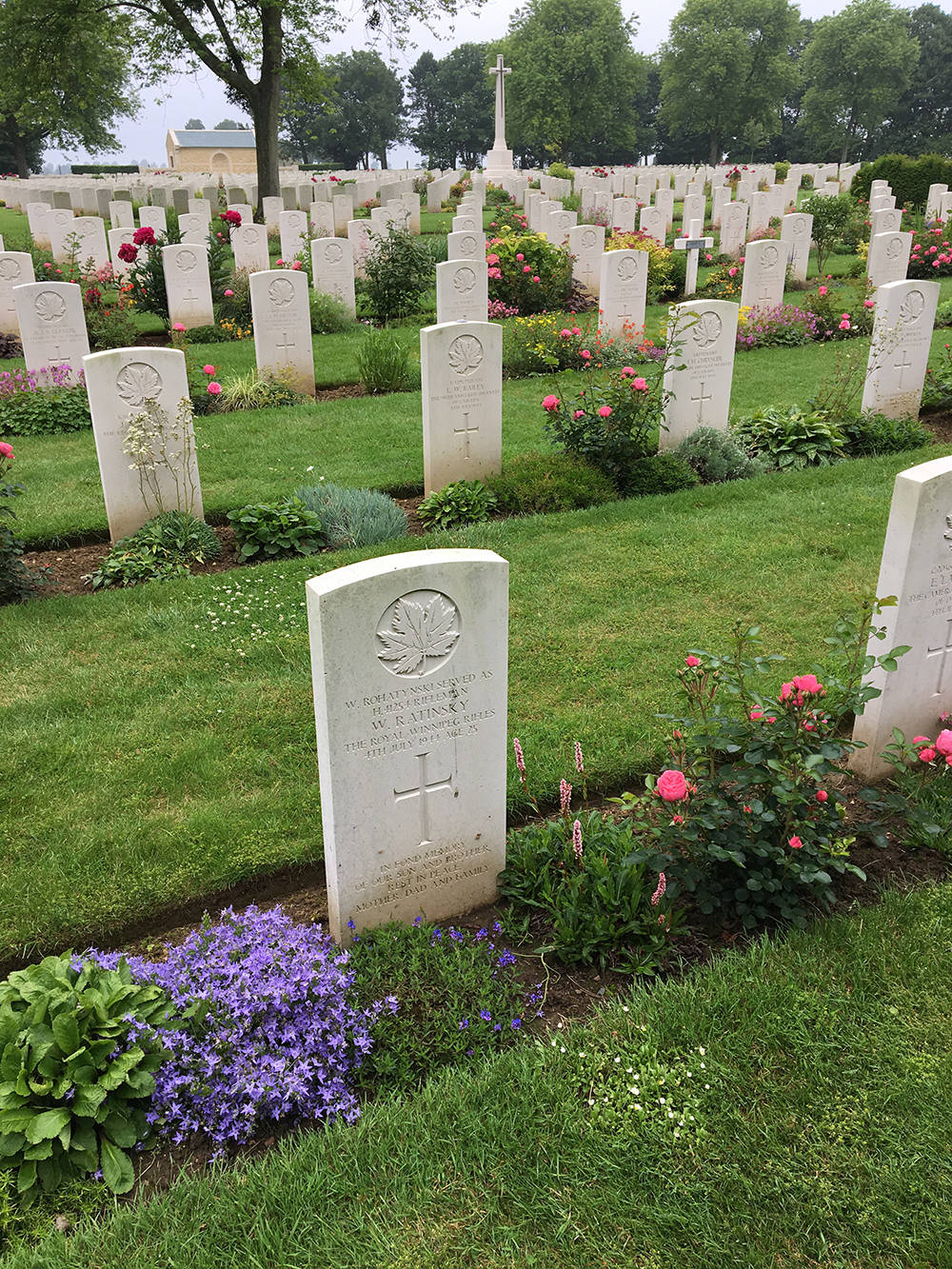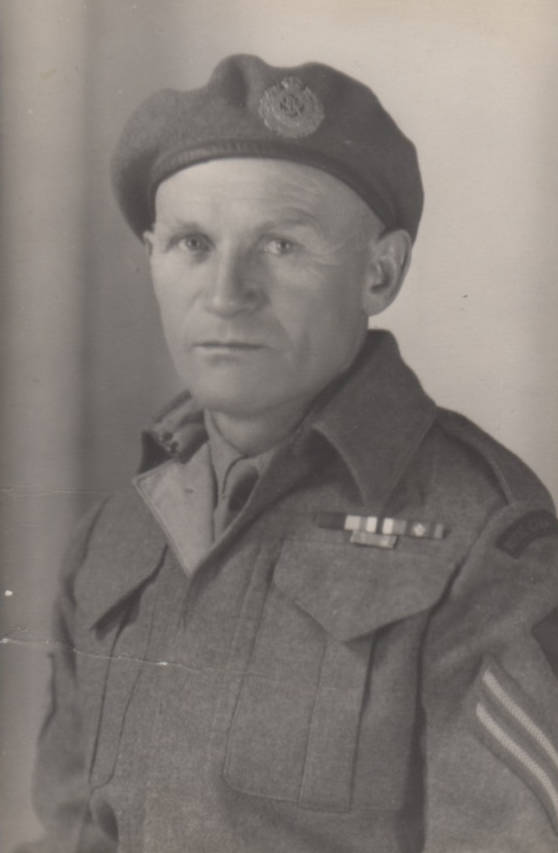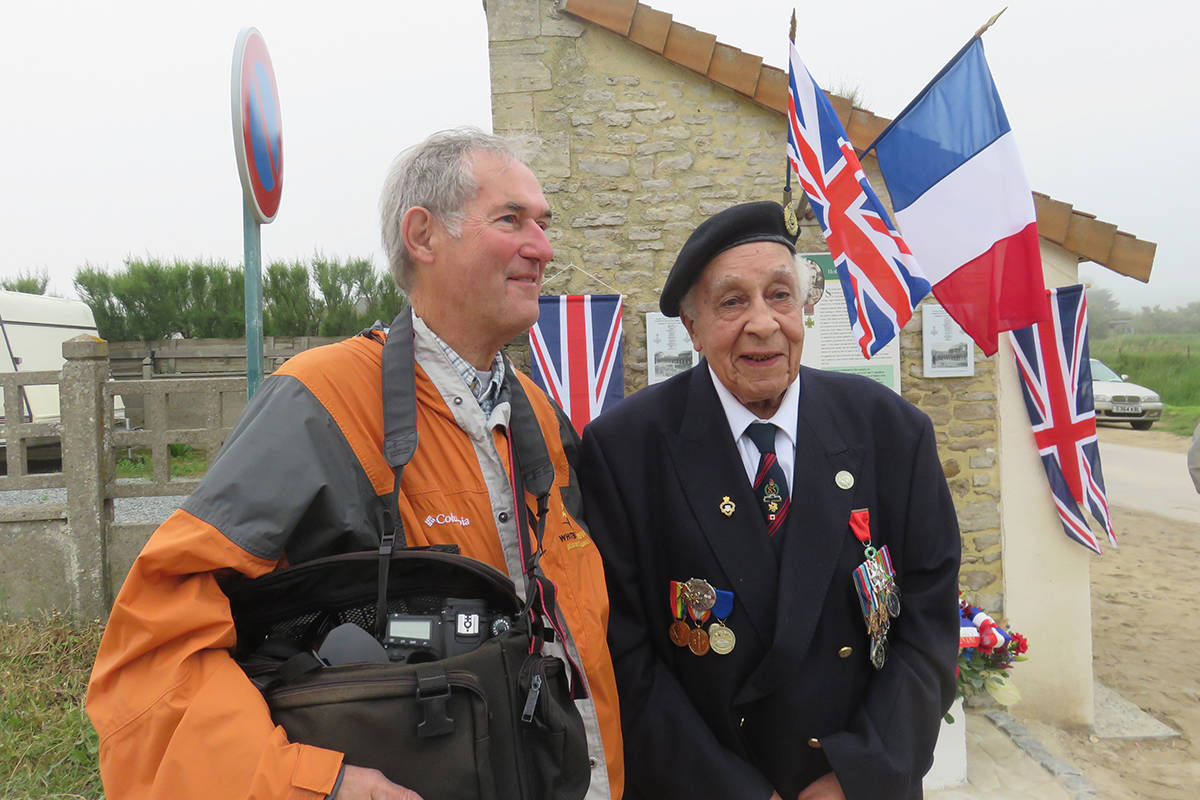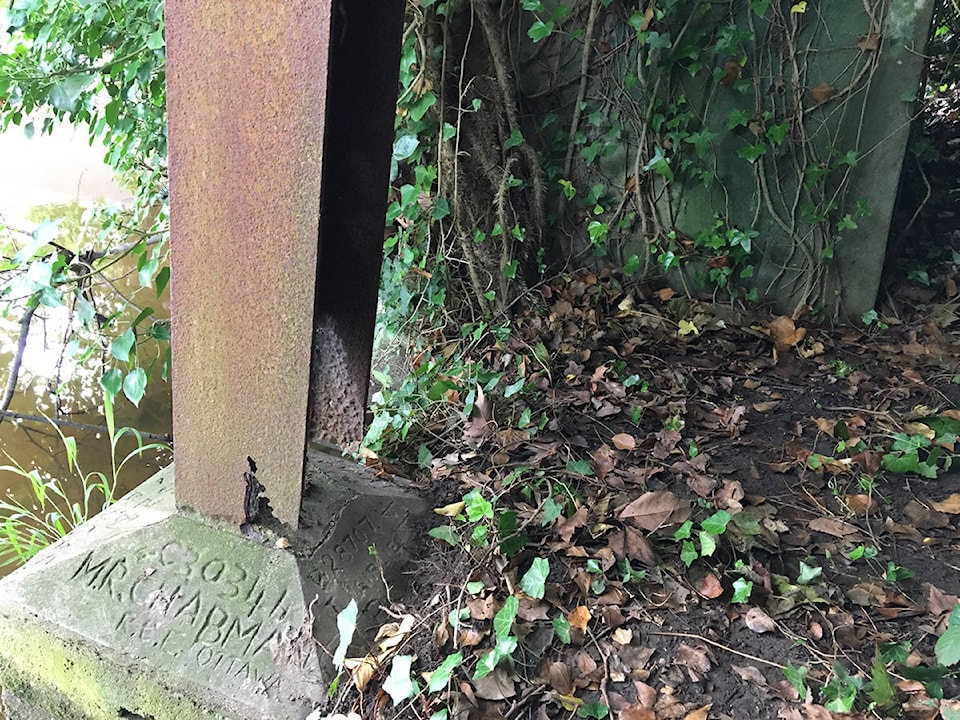By Gord Yakimow
Special to The Progress
“The new bridge is there,” pointed my war-sites guide. “So the old Bailey bridge would have to be pretty close …on one side or the other.”
I went crawling through the bush and the undergrowth along the edge of the murky river, and in short order came across a cement footing which had a rusting steel support piling rising up from its centre. Into the cement were scratched four names and serial numbers:
C30344 MC Chabman RCE Ottawa
K50640 W Kwiozak RCE 29/8/44
H195281 EE Kang RCE
B28707 T Fairlie RCE 44
AThe names and serial numbers engraved were all members of the Royal Canadian Engineers (RCE). The date etched into the cement was D+84 — almost three months after the D-Day invasion of June 6, 1944.
“The RCE were tasked with building or rebuilding airports, roads, bridges (and the like) which had been damaged or destroyed by shelling from the attacking Allied forces or by the retreating German army,” explained my guide.
| John Yakimow, serial number H39252, Second Battalion, Royal Canadian Engineers |
Earlier that day we had visited the Carpiquet Caen Aeroport. “Your father’s battalion rebuilt this airport,” he asserted. “A functioning airport was necessary in order to bring in planes and supplies for the liberating forces,” he explained. “He was close enough here to the front line to be able to see and hear the battle.”
My father never talked to me much about his war-time experiences, although I think he did so with his buddies down at the local Legion Hall. At his funeral they had a colour guard, and they fired off a gun salute over his grave. Once, he had been wounded. Another time two fellow soldiers standing beside him were killed by a sniper, he the only one of the three to survive.
As a child I remember him calling out in the dark of the night … my mother calming him down. War-time wounds were more than just physical wounds.
Now in my 70s, after a long and peaceful teaching career, I had had on my “bucket list” the following undertaking: to visit First World War and Second World War sites associated with Canadian forces, and especially to retrace some of the movements of my father’s unit — D Company, 2nd Pioneer Battalion, Royal Canadian Engineers. My guide was Jim Smithson, an affable Englishman, and like me, a retired teacher. Smithson has a passion for and an encyclopedic knowledge of the wretched situation (for both sides) on the Western Front of the First World War, and of the D-Day landings and the aftermath in the Normandy of the Second World War.
Smithson took me to a lot of places associated with both wars — Juno Beach and Vimy Ridge and near-by Hill 70 (where six Canadian were award the Victoria cross - for exceptional bravery in the face of the enemy). He took me to Passchendaele and Ypres and to the site of the advance field hospital of Dr. John McCrea, famous for his evocative poem “In Flanders’ Fields.” We went to the Canadian “Brooding Soldier” monument, and to a New Zealand monument where the inscription reads “From the Uttermost Ends of the Earth,” and to Polygon Wood, which resonates significantly with Australians. He took me to museums and monuments and battle sites and cemeteries - of which there are about a thousand in Normandy and in Flanders (northern France and southern Belgium), some small with only a few dozen headstones, some large with thousands of headstones. Many were marked “Unknown Soldier.” For those who never came home and whose remains were never identified, there were memorial walls upon which were inscribed their names. Tens of thousands of names.
A magnificent bronze caribou stands above a wall at the Beaumont-Hamel Newfoundland Memorial, which has on it 814 names: soldiers and sailors and merchant mariners whose bodies were never located. Ninety percent of the Newfoundland regiment was wiped out at the site on July 1, 2016. At the time Newfoundland was still a independent dominion with its own unique flag – not yet a province of Canada.
The Canadian Memorial on Vimy Ridge near Arras has on it the names of 11,000 Canadians whose remains lie somewhere in the fields of Flanders or the Somme or the Ypres Salient - either in a grave marked “An Unknown Soldier from the Great War,” or somewhere still beneath the dirt and clay of what was once the Western Front. Their remains have never been identified.
The Thiepval Memorial is to Great Britain what the Vimy Memorial, 50 kilometres to its north, is to Canada. What is poignant about Thiepval is that the memorial at the site has inscribed onto it 72,000 names – young men killed in the Somme, most between July and November of 1916 … their remains never identified.
On the Menin Gate in Ypres, Belgium, there are inscribed the names of 54,000 soldiers – killed in the fields of Flanders, their remains never identified.
Three war cemeteries are located near the village of Neuville-Saint-Vaast, in the gentle hills of the Artois region of France.
One is the largest German First World War cemetery in France, located just south-west of the Canadian Vimy Memorial which can be seen from its entrance. An earth embankment upon which grow hedges discreetly obscures the German La Targette Neuville-St Vaast Cemetery from passing traffic; it is barely noticeable from the road. Few Germans visit here. A PostMedia newsman staked out the cemetery for three days in 2014 in order to talk with any Germans who had an association there; no one came. One sombre family in a vehicle with German licence plates did visit in the hour that we spent there.
A plaque mounted on a brick wall just inside the entrance informs visitors that within lie 44,833 burials. Just over 8,000 are not identified.
The austere cemetery, administered by the German War Graves Commission, contains crosses of metal; many of the crosses have inscribed upon them four names - one for each side of the arms of the cross – four soldiers per grave. About 100 have stone grave markers with the Star of David – German Jews who gave their lives for Germany in First World War.
Not far away is the French National Cemetery, the largest one by area in France. It too has crosses, but of marble: 12,000 soldiers rest here; most are French casualties of the first war. But the cemetery also contains soldiers killed in the Second World War. And a few Jews upon whose headstones is the Star of David. And a number of Belgians. And a few Poles and a few Hindus. Those in the Muslim section lie beneath headstones turned toward Mecca.
Adjacent is a much smaller British cemetery. Interspersed among its 638 graves (including five Canadians killed at near-by Vimy) is an appealing landscaping of shrubs and flowers, common for all cemeteries administered by the Commonwealth War Graves Commission.
Some 350 kilometres to the south-west in Normandy are many more resting places of soldiers who died thirty years later - in the Second World War, the war in which my father fought: John Yakimow, serial number H39252, Second Battalion, Royal Canadian Engineers. [The “War-To-End-All Wars” turned out not to be the “war-to-end-all-wars.”]
One is Beny-Sur-Mer near Caen, where early Canadian casualties from the D-Day Invasion are interred … just over 2000. Three thousand lie in near-by Bretteville-sur-Laize Canadian War Cemetery, of which 89 are “unknown soldiers.”
Mine was a poignant, heart-wrenching experience. Visiting two sites near Caen associated with my father’s wartime activity was emotionally overwhelming. So too was the reading through of an obscure hurried history of my father’s battalion which Jim Smithson, in his researching zeal, had located. Written at decommission by Regimental Sergeant-Major A. Lockwood, the account traced the movements through France, then up to Belgium and Holland, and finally eastward into Germany as the front advanced. “That’s Alec Lockwood,” I blurted. “My father kept in touch with him after the war. They visited, exchanged Christmas cards.”
I took 1,600 photos in the time that I spent in the two war zones. A few are printed here with this article. The most special ones are of the cement footing upon whose four surfaces were etched the names and serial numbers of four of my father’s Second World War fellow soldiers.
Gord Yakimow was head of the English department at Chilliwack Senior Secondary for 15 years until his retirement.



